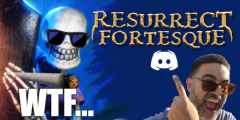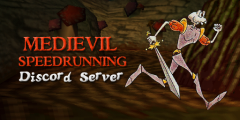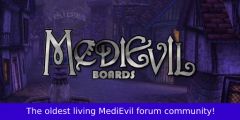MediEvil 2
MediEvil 2 (stylised as MediEvil II in North America) is an action-adventure video game and the second installment in the MediEvil series. It's a sequel to MediEvil, taking place 500 years after the game's events. It was released on May 9, 2000 in North America and April 19, 2000 in Europe.
| MediEvil 2 | ||
|---|---|---|
| [[Image:<tabber>
PAL=
File:MediEvil2cover.png|250px]] | ||
| Memory Card icon | File:Memory Card 2.png | |
| Tagline(s) | The Return of the Laughing Dead. The gothic journey to die for. | |
| Platform(s) | PlayStation | |
| Ratings | ESRB: Teen ELSPA: 11+ OFLC: M15+ | |
| Mode(s) | Single-player | |
| Previous game | MediEvil | |
| Next game | MediEvil: Resurrection | |
Gameplay
MediEvil 2 contains several of the original forms of gameplay, weaponry and graphics that were present in the first title of the series. Whilst featuring many of the classic swords and other medieval weaponry, long range weapons are more modern, taking the form of pistols, shotguns and a gatling gun. Progress through the game is a bit more linear and story driven.
New Features
- Weapon toggle: Two weapons can be selected from the inventory, so players can easily switch between them. By default, + changes weapon.
- Camera controls: It is now possible to control the game camera with the right analog stick.
- Dan-hand: Unlocked halfway through the game, Dan can place his heads on one of the scuttling green hands in order to get into small areas to solve puzzles or access hidden treasure. Whilst in this mode, Dan can freely swap between his head and his body. This does come with risks, as Dan-hand has no attacks and is quite vulnerable. Sometimes Dan's head will be stolen by a bird on certain levels, and Dan must climb to their nest to retrieve it. While Dan's head is off, octomators can also attach themselves on top of Dan and sap his health; rapidly pressing action will shake them off. + switches between Dan and his head, or puts it back on when standing over it.
- Dankenstein: One of the levels involve Dan fighting in a boxing match, using a Monster-esque body, against a large robot. The fighters fight each other, with limbs coming off after certain amounts of damage. Up to two lost limbs can be recovered between rounds (after defeating the imps who are carrying them around). Dan will lose if he loses all his limbs, or if he is unable to defeat his opponent in three rounds.
Changes
- Linear Progression and Level Selection: There is only one choice of next level, unlike at certain points in the first game, as the game doesn't feature a map. A projector in the Professor's Lab displays a single level onto a board and the player can scroll left or right one at a time to choose a level. Sometimes new levels will start immediately after completing one without first returning to the lab. Unlike in the first game you can ask the Professor to give you a mission briefing for a level.
- Spiv: The Spiv character replaces the Merchant Gargoyles from the first game.
- Start-of-Area Saving: As some levels in the game are made-up of more than one area, Winston the Ghost will offer you the chance to save inside a new area (after a load sequence), which often occurs before boss fights, using the phrase "Alright Dan, you've come a long way. I'd save if I was you!"
- Falling Damage: Unlike in the previous game, when falling from a height Dan will now receive damage. Dan will either lose health or die instantly, depending on the height from which he falls.
Characters
- Sir Daniel Fortesque - The protagonist of the game. He was the captain chosen to lead the fight against Zarok, but was killed by an arrow during the first charge. He was later resurrected when Zarok returned to terrorize the land once again. This time Sir Dan was able to defeat his nemesis, restoring his name and proving himself to be a true hero. He is a skeleton with no lower jaw, therefore he humorously mumbles in speech although unlike in the first game, the player can understand him. Compared to the first game, his design was slightly modified. His head is a little larger, and he also wears leather gloves.
- Professor Hamilton Kift - A nervous, fast-talking professor in the laboratory near an unused underground rail station. He's a somewhat short man with mechanical hands and a large head. He is skilled in different forms of science, philosophy, the occult and has a knack for creating inventions. Collecting the Chalice in each level provides him the materials to create a new weapon.
- Princess Kiya - A soft spoken mummy who has been dead inside her tomb for thousands of years and enunciates every word she says carefully. She is blue in skin color and wears bandages. She knows embalming techniques and is grateful to Sir Dan for having rescued her from her eternal prison.
- Winston Chapelmount - A cheery young ghost with large eyes. His name is a play on Winston Churchill. His history creates a spectral shadow, upon which he can be called to provide help for Dan. He teaches Dan how to find and use ancient magic. He also provides save points on long levels and on a few occasions relays Dan's earned weapon to him when he is unable to access the Professor's lab.
- Lord Palethorn - The villain of the game. His motive is to find all the lost pages of Zarok's spellbook so he can gain control of London. He was once an acquaintance of the Professor and was the one responsible for damaging his hands before being banished from the cult. He is voiced by Steven Blum.
- Mander - Lord Palethorn's associate, he was turned into a lizard during the spell and is notably smarter than Dogman.
- Dogman - Dogman is Lord Palethorn's muscle man. He was also another victim of Palethorn's spell, turning him into a dog.
Plot
Template:Spoilers In Kensington in the year 1886, 500 years after Sir Daniel Fortesque's climactic battle against the evil sorcerer Zarok, a sorcerer named Lord Palethorn discovers some of the pages of Zarok's spell book and casts the Spell of Eternal Darkness over the city of London. However, Palethorn needs the final pages of the spell book to fully control the monsters he has spawned. The spell Palethorn casts once again brings Sir Dan, who was resting at a nearby museum back to life. He is recruited by a professor named Hamilton Kift and his ghostly sidekick Winston to recover the missing pages of Zarok's spellbook and put a stop to Palethorn's plans. Along the way, they end up being joined by an ancient mummy princess named Kiya, who becomes Dan's love interest.
During an incident in which Kiya goes off on her own, she is killed by Jack the Ripper, much to the shock of Dan. Discovering a time machine, Dan travels back in time in order to save Kiya, merging with his past self to gain super armour. As Dan finally confronts Palethorn, he steals the final page from him and uses it to summon a demon. However, Dan manages to turn the demon against Palethorn, putting a stop to both of them.
Endings
- Not all chalices collected: As Palethorn blows up his lair on his dying breath, Dan decides to join Kiya together in the afterlife as they return to their eternal rest in The Museum.
- All chalices collected: If the player has collected all the Chalices of Souls, Dan and Kiya will instead go for a ride on the time machine, which takes them back in time, but also to an alternative timeline, where Palethorn had used the spell book to travel back and rewrite time.[1]
Cover art and CDs
<tabber> PAL (European)=
- MediEvil 2 - Front Cover PAL.JPG
Front Cover.
- 1332163-medievil2plat eu ps front super.jpg
Platinum Front Cover.
- SCES-02544-I-ALL.jpg
Inlay
- SCES-02544-D-ALL.png
CD
- SCES-02544-B-ALL.jpg
Back Cover.
- SCES-02545-B-ALL.jpg
Alternate Back Cover.
|-| NTSC (American)=
- MediEvil II - Front Cover NTSC.jpg
Front Cover.
- MediEvil II - Back Cover NTSC.jpg
Back Cover.
- SCUS-94564-D-ALL.png
CD
</tabber>
Reception
| Reception | |
|---|---|
| Aggregate scores | |
| Aggregator | Score |
| GameRankings | 79.47%[2] |
| Review scores | |
| Publication | Score |
| Absolute PlayStation | 79%[3] |
| Electronic Gaming Monthly | 6.8/10 |
| Game Informer | 7.75/10 |
| Game Revolution | B+[4] |
| GameSpot | 7.6/10[5] |
| Hyper | 8.5/10 |
| IGN | 8.4/10[6] |
| Official PlayStation Magazine (US) | 3.5/5 |
The game received good reviews from critics, with an 79.47% aggregate rating at Game Rankings.[2] The game was criticized by reviewers for its bad camera angles at points, difficulty and for sometimes being confusing, but was praised for its humor and approachability, among other things. IGN gave the game a score of 8.4, stating that the game "is clever, sick, and funny" and better than the first.[6] Gamespot gave it a 7.6, praising the content and features while criticising the camera.[5]
Chris Sorrell, the director of the first game, had this to say about the game:
|
On April 9, 2000, the game won the BAFTA award for Best Console Game.[7][8]
- Bafta.jpg
From left to right - Andrew Kennedy, James Shepherd and Jason Wilson.
- Bafta now.jpg
The BAFTA is currently in Jason Wilson's possession.
Credits
| Producer: | Andrew Kennedy |
|---|---|
| Studio Director: | Simon Gardner |
| Creative Director: | James Shepherd |
| Lead Programmer: | Julian Rex |
| Main Programming: | James Busby, Paul Donovan, Martin Hamilton Kift, Alan McCarthy, Steven Tattersall, Iain Brown, Gavin Clarke, Gavin Bell |
| Additional Programming: | Will Bell, David Nicolier |
| Mapping: |
Gareth 'Royston' Hughes, Dave 'Dazzler' Holloway, Katie Lea, Jon Double |
| Art Design: | Jason Wilson |
| Art Management: | Nina Kristensen |
| Technical Artist: | Jason Evans |
| Lead Enviroment Artist: | Pete Giles |
| Lead Rendering Artist: | Jason Riley |
| Assistant Art Design: | Leavon Archer |
| Rendered Sequences: | Jason Riley, Phil Lukasz, Kelly Scott, Justin Summers |
| Presentation Visuals: | Jason Riley, Iwan Scheer |
| Character Animation: | Matt Bagshaw, Justin Summers, Jason Evans, Phil Lukasz, Kelly Scott, Mike Philbin, Mitch Phillips |
| Enviroment Art: | Pete Giles, Ben Levitt, Jason Evans, Theo Pantazi, Jesus Cobo, Leavon Archer |
| Character Art: | Matt Bagshaw, Jason Evans Justin Summers, Leavon Archer |
| AV Management: | John Meegan |
| Original Soundtrack: | Andrew Barnabas, Paul Arnold |
| Sound Effects: | Paul Arnold, Andrew Barnabas |
| Video Post-Production: | Andrew Barnabas, Alex Sulman |
| Speech Post-Production: | Paul Arnold |
| Sound Effect Programming: | Gary Richards, Gavin Bell |
| Technologies Programming: | Chris Sorrell, Andrew Ostler, Julian Rex, Dean Ashton, Simon Brown, Mike Froggatt, Iain Brown |
| QA Manager (Cambridge): | Alex Sulman |
| QA Team (Cambridge): | Simon Brace, Robert King, Kieran MacDonald, Neal Radcliffe |
| QA Manager: | Geoff Rens |
| Internal Testing Manager: | Chris Rowley |
| QA Co-Ordinator: | Jim McCabe |
| Lead Testers: | Matt Ekins, Phil Green |
| Testers: | Carl McKane, Richard Bunn, Anthony Gill, Darren Perkins, John Cassidy, Miguel Sanchez |
| Copywriter: | Jim Sangster |
| Script: | James Shepherd |
| Additional Script: | Jim Sangster |
| Voice Actors: | Melanie Hudson, Marc Silk, Ben Stephens |
Gallery
Official screenshots
- 1.jpg
- 2.jpg
- 3.jpg
- 4.jpg
- 5.jpg
- 6.jpg
- 7.jpg
- 8.jpg
- 9.jpg
- 10.jpg
- 11.jpg
- 12.jpg
Videos
- MediEvil 2 - Promotional Trailer (EU)
Promotional Trailer (EU)
Trivia
- The original idea for the game had Zarok being kept prisoner in the Tower of London with Dan having to free him. The two of them then had to work together in an uneasy alliance.
References
- ↑ Interview with Jason Wilson on MediEvil Boards. Published February 10, 2012.
- ↑ 2.0 2.1 MediEvil 2 for PlayStation on GameRankings.
- ↑ MEDIEVIL 2 - Review on ABSOLUTE PLAYSTATION. Published May 2000.
- ↑ MediEvil II Review on Game Revolution. Published May 2000.
- ↑ 5.0 5.1 Joe Fielder, MediEvil II Review on GameSpot. Published October 23, 1998. Cite error: Invalid
<ref>tag; name "GameSpot" defined multiple times with different content - ↑ 6.0 6.1 Doug Perry, Medievil II on IGN. Published May 22, 2000.
- ↑ Games - Console in 2000 on BAFTA AWARDS.
- ↑ Art and Game Design - MediEvil on JASON WILSON - PORTFOLIO.
External links
- Official Website
- MediEvil 2 on TCRF.
- MediEvil 2 on the UVL.
- MediEvil 2 on the Voice Over Wiki.
- MediEvil 2 at Wikipedia.
Template:Games Template:MediEvil 2 FMVs
| ||||||||||||||
Gaming Wiki Network
 Discord • Twitter |
The GWN is an affiliation between independently-hosted wikis about video games. | ||
|
We are also affiliated with:
| |||





